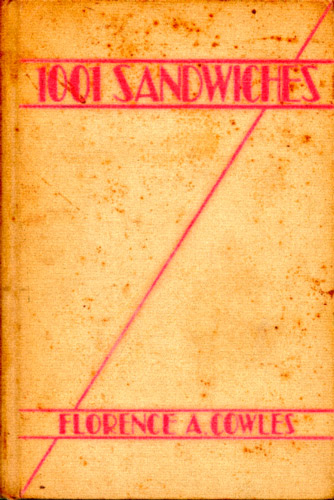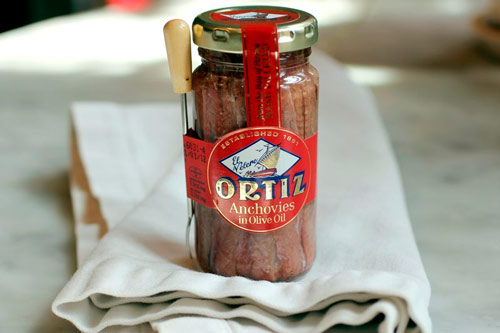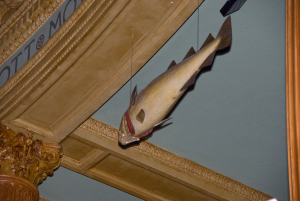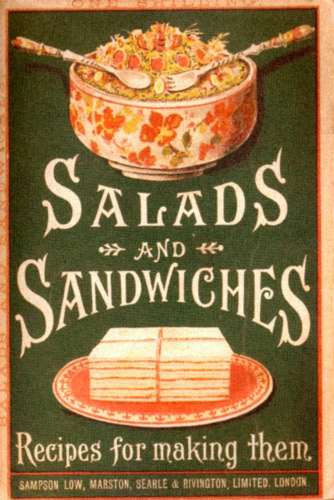The mysterious Florence Cowles & her thousands of sandwiches, featuring many sardines, musings on architecture & the unlikely Dafigconuchocarbutt.
1. A degree of confusion.
In 1928, a book called Five Hundred Sandwiches by Florence A. Cowles first appeared, in Boston. A British edition followed quickly in 1929, along with Seven Hundred Sandwiches, published during the same year in Boston but not London.
The publishing history of the book appears murky. Some editions of Seven Hundred Sandwiches included only the text of the Five Hundred. But no matter; the book (books?) was popular, and emboldened Mrs. Cowles to write her epic 1001 Sandwiches, which first appeared in 1936 and remained in print at least until 1952.

No evidence suggests that the magnum opus ever reached Britain but, curiously, Five Hundred Sandwiches reappeared there as late as a 1939 edition, an indication of a solid decade’s popularity. No trace, however, of a British Seven Hundred either.
Mrs. Cowles herself remains a shadowy figure, at least to the Editor. No biographical details appear online and she gets no entry in the comprehensive University of Oxford American National Biography. In fact, the only volume in the Oxford library system that mentions her name is the first British edition of Five Hundred Recipes, which English law required the publisher to send to the university because, like the United States Library of Congress, it is a statutory copyright library entitled to receive every book published in the United Kingdom.
2. A Bostonian…
Nonetheless Mrs. Cowles quite obviously was American, and it is nearly certain that she came from Boston, or at least from Massachusetts. She uses cornbread along with “American” and “York State” [sic] cheese while devoting an entire chapter to nearly four dozen kinds of peanut butter sandwich.
She intends her ‘Flag Sandwiches I and II’ to resemble the stars and stripes. ‘II’ for example assembles “stripes of egg white chopped fine and pimiento” while using “chopped olives for blue field and bite of egg white for stars.” Mrs. Cowles also includes a “Patriotic Sandwich (For July Fourth).” It requires the reader to place a paste of butter and red pimiento “between thin slices of white bread and tie with a blue ribbon.” (1001 Sandwiches 234, 235)
3 …influenced by England.
Not that the English evidence is absent, as we may infer from this patriotic paste. Like Oswell Blakeston, Hilda Leyel, ‘T. Hardy’ and our other English sandwich makers, she uses a lot more pastes and compound butters than most American writers. ‘Sandwich Butters’ are, she notes, “exceptionally dainty for afternoon tea” and sandwiches filled with them need not include anything else. (1001 Sandwiches 116)

Anchovies, the ancient import and constant English seasoning through the centuries, appear and the sardines that populate the sandwiches of interwar English cookbooks abound in these pages, while a fondness for potted and devilled foods also characterizes all three Sandwiches.
We cannot prove why the English influence persists, but Boston was, even as late as the middle of the twentieth century, unusually Anglophile in cultural terms for an American city.
And so to other evidence tying Mrs. Cowles to the Hub of the Solar System. “Boston brown bread” provides the carrier for her “Baconbean Sandwich;” she likes Parker House Rolls; and offers “Boston” as well as “Bay State” sandwiches. Each of them leans heavily on baked beans, along with at least ten of her other sandwiches, a rather high head count for so unorthodox an ingredient unless, of course, you hail from the land of the bean and the cod.

The Sacred Cod of Massachusetts
4. Unfortunate acronyms.
As with the “Baconbean,” Mrs. Cowles like to give her sandwiches names derived from their constituents. The “Dafigeo” and “Gindanutra” are irksome examples and from the section on sardines alone we get “Cressardine,” “Devildine,” “Horsardine,” “Sardinegg,” “Sardinoil” and “Sardolive” sandwiches.
If all this should lead us to dismiss Mrs. Cowles as a bit of a fool we would be mistaken. Obviously enough she covers a lot of ground, and intersperses lot of useful, intriguing sandwich combinations amidst the forced whimsy.
5. A disquisition on the construction industry.
The Sandwiches also reflect a briskly sensible sense of humor. On the club sandwich:
“Who invented and christened the club sandwich? And how, why, when and where? No authoritative answers to these questions are available…. Anyway, who cares, and what difference does it make? The club sandwich is here to stay.” (1001 Sandwiches 215)
But while welcome, the club harbors a darker side: “If built up in story formation they are somewhat formidable and attack is sometimes disastrous.” Fear not, however, for Mrs. Cowles suggests a remedy, her “bungalow style” with “all ‘rooms’ on the first floor” based upon “a firm foundation of plate.” (1001 Sandwiches 215) It would seem that skyscraping is integral to the concept of ‘club’ but then, as the slackers say, ‘whatever.’
The gaffe is forgiven because her ‘clubs’ are good, particularly the ones furnished with shellfish. These include a minimalist crab salad garnished with tomatoes (an imposter on the club scene; one of the single story bungalows), and a baroque assemblage of fried oysters, bacon, chicken, horseradish, pickles and more; a juiced up Anglo-New Orleanian peacemaker gone vertical.

6. The transatlantic lure of the anchovy.
The British style recipes work too, in combinations either novel or forgotten west of the Atlantic. Like Blakeston, Mrs. Cowle likes that British classic for topping both fish and meat as well as enhancing sandwiches, anchovy butter.
Both of them include a recipe for the perfect pairing of anchovy and olive. The combination is a classic, and not only for sandwich filling; the green olives stuffed with anchovy that Goya imports from Spain are a Thing We Like.
You might mash them with some butter for a simple treat, or choose instruction from either author. Blakeston: “Pound the anchovies with stoned olives. Mix in a little cayenne.” Cowle: “Spread thin slices of bread with a very little butter and cover with a thin layer of anchovy paste mixed with fine-chopped olives.” (Edwardian Glamour Cooking Without Tears, London 1960, 55; 1001 Sandwiches 77)
The two recipes incidentally demonstrate the age old fact that in the hands of different cooks even the simplest preparation will wind up with each one’s individual stamp.
Mrs. Cowles also chooses the flavors of a classic British savory. Instead of broiling (in America) or grilling (in Britain) anchovy with Parmesan on toast, she makes a filling for buttered white bread:
“Remove bones from a dozen anchovies; add yolks of three hard-cooked eggs and mash. Mix two tablespoons of Parmesan cheese with half a saltspoon of cayenne; add to anchovy mixture with enough cream to make of spreading consistency.” (1001 Sandwiches 78)
Sublime, like an elegant Gentleman’s Relish on steroids.
7. Don’t forget the beef (entailing a hint).
Other combinations are almost intuitive and yet original riffs on established themes. Mustard of course enhances corned beef, the filling for the first sandwich of them all. Mrs. Cowles takes things further by mincing the meat and some mustard pickle (or chowchow or piccalilli depending on your dialect) to mix with traces of cayenne, mayonnaise, sugar and Worcestershire.
Finally for our immediate purpose we find an “England Sandwich” and it does the name proud. To find out why, follow our recipe in the practical. A selection of other recipes inspired by Mrs. Cowles appears there too.
Note:
- The ‘Dafigco’ sandwich contains dates, figs, coconut, nuts, chocolate, sugar, and butter; Mrs. Cowles might have gone all out and christened it the ‘Dafigconuchocarbutt.’ The ‘Gindanutra?’ It moistens a combination of ‘chopped preserved ginger,’ dates, unspecified nuts, raisins and citron (the odd ingredient out in terms of nomenclature) with orange juice to make a spread that is “[g]ood on any kind of bread.” (1001 Sandwiches 161)

